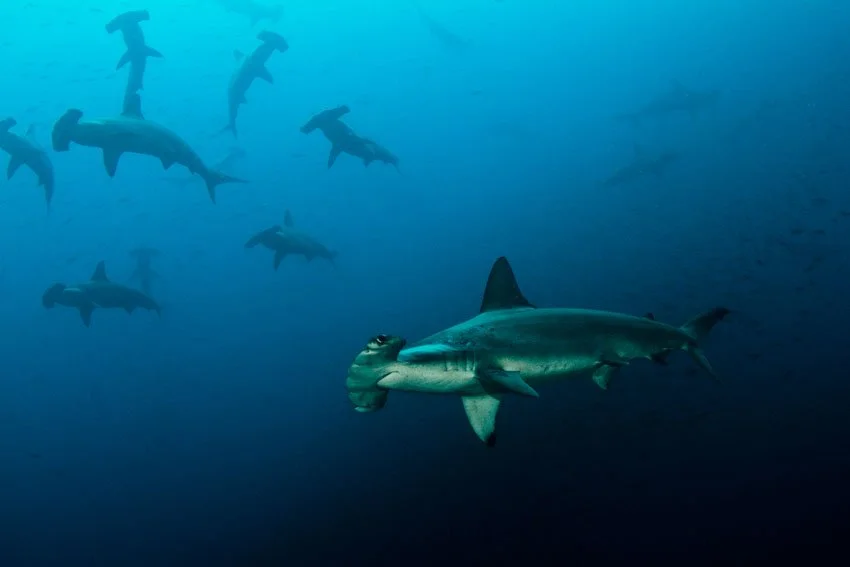The Galapagos Islands are one of those places that exist in a category of their own, and the northern islands of Darwin and Wolf even more so. Raw, remote, and teeming with life, they offer the most mind-blowing diving on the planet. Think schooling hammerheads, playful sea lions, and the chance to see things you didn’t even know existed. But diving here isn’t your average tropical vacation—it’s an adventure, and a liveaboard is the best way to experience it. Here’s what to expect and how to prepare.
The Diving: Big Animals & Big Currents
Let’s get one thing straight: diving in the northern Galapagos Islands is not for the timid. The water can be chilly and choppy, the currents significant, and the sharks abundant. But all of that is just part of the magic.
Darwin and Wolf, the crown jewels of Galapagos diving, are where you’ll find massive schools of hammerheads, silky sharks, and, if you’re lucky, a whale shark cruising by. Around the western islands of Isabela and Fernandina (not all liveaboard itineraries include these, but I highly recommend one that does, like my Galapagos Dive Expedition), expect playful sea lions buzzing past you, marine iguanas munching on algae, and maybe even a Galapagos penguin basking on shore. It’s a mix of big-ticket animals and bizarre endemic species that make you feel like you’ve splashed down in another world.
The Liveaboard Experience: Eat, Sleep, Dive, Repeat
A liveaboard in Galapagos isn’t just about the diving—it’s about fully immersing yourself in the experience. Days start early with a briefing and a pre-breakfast dive, followed by a second morning dive, a hearty meal, and an afternoon of more diving and snacks. By the end of the day, you’re exhausted in the best way possible.
Liveaboard-vessel quality varies widely in the Galapagos, so look for one that suits your comfort level. I personally love the Explorer Venture fleet, which includes two liveaboard ships in the Galapagos. The Humboldt Explorer and the Tiburon Explorer both offer itineraries to the northern islands, and both are perfectly outfitted to provide experiences marked by safety, comfort and exhilaration, both above and below water. The Tiburon also offers itineraries including the western islands of Isabela and Fernandina where you’ll search for diving marine iguanas, penguins, Mola molas and can cross your fingers to witness a live volcanic eruption.
It is important to keep in mind that while comfortable, these are not spa cruises. Between the early mornings and the adrenaline-fueled dives, expect to fall asleep hard at the end of each day. A good way to prepare is by making sure to take care of yourself prior to the trip with plenty of sleep, well-balanced meals and a regular fitness routine (shouldn’t these always be part of our lives anyway?!). Another good tip is to arrive a couple of days early so that you can adjust from the travel and board the boat fresh and ready to go. It also affords you the opportunity to explore all the wonderful sites the islands have to offer on land.
The Logistics: What You Need to Know
Packing for Galapagos diving is a little different than your standard warm-water trip. A 5mm wetsuit is a good idea, as temperatures hover around 70 degrees Fahrenheit in most areas, and can dip into the high 50s/low 60s at select dive sites in the west. I love my Aqualung AquaFlex 5mm wetsuit for the exceptional warmth and comfort it provides. I also love bringing along a reusable heat pack to stuff in my wetsuit for the last dives of the day. Gloves do wonders for keeping warm and gripping onto rocky surfaces.
Liveaboards in Galapagos tend to book out far in advance, so plan accordingly. If you’re prone to seasickness, it’s worth bringing motion sickness remedies, as the crossings between islands can sometimes be a little bumpy. Although I don’t suffer from seasickness (knock on wood), I always carry Bonine just in case.
Another essential in my bag is electrolyte salt. Throughout a long day of diving, you will become dehyrdated much quicker than you would think, and it’s critically important to hydrate properly. Dehydration is believed to be a leading factor in DCS, so drinking plenty of water and salts, and avoiding too much caffeine and alcohol is key. You can read more about some of the risk factors for decompression sickness and how to reduce your risk in my series of DCS blogs.
The Takeaway
A liveaboard in Galapagos is not your average dive trip—it’s a front-row seat to some of the most incredible marine life encounters on Earth. The conditions create the perfect environment for world-class diving, and also add some extra excitement. With the right preparation and a good sense of adventure, this is a trip that will stay with you forever.
Ready to check Galapagos diving off your bucketlist? Click the button below for more details on my Galapagos Dive Expedition for 2026!
